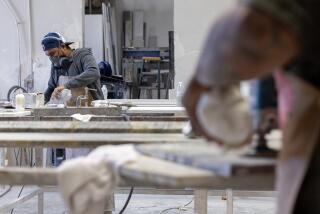Tougher Seismic Laws Urged for Hospitals : Safety: Medical personnel support proposed measure to require that older buildings be reinforced to meet current regulations.
- Share via
Nurse Cathy Carder, who was on duty in the critical care unit at Santa Monica Hospital Medical Center when the Northridge earthquake hit, doesn’t believe she will ever forget the terror.
“Along with the shaking, I could hear people yelling, things falling and crashing. . . . The elevators weren’t working, water was pouring (through the ceiling), we had no telephone service . . . we smelled leaking gas.”
She and other nurses managed to evacuate all the critical patients, using hand pumps to keep the respirators going when the power went out, or stayed with them in the quake-damaged building until help arrived. “We definitely were in fear for our lives,” she said.
Carder believes that she and the patients were lucky. So do a lot of other people.
Hoping to avoid a replay, she joined hospital officials, doctors, and other nurses at a news conference Friday at Cedars-Sinai Medical Center in support of legislation to toughen the earthquake safety laws that affect hospitals.
The announcement of the legislation was made by Assemblyman Burt Margolin (D-Los Angeles), the chairman of the Assembly Health Committee who will carry the bill. Margolin said the bill, which could encounter strong resistance in the Legislature, would require older hospitals to meet the same stringent requirements demanded of hospitals built after 1973, when seismic safety legislation was passed in the aftermath of the Sylmar earthquake.
The news conference was held at Cedars-Sinai because its experience was typical of the way other hospitals fared. Newer buildings held up, older ones failed.
A key feature would be the requirement that older hospitals undergo retrofitting to make them as strong as hospitals built after 1973. Margolin said he wants a time limit set, possibly 10 or 15 years after the law is passed, requiring hospitals either to retrofit or close.
Margolin, a Democrat who is running for state insurance commissioner, said he will ask the Legislature to require more frequent inspections by state safety engineers and tougher standards for mechanical systems.
Mechanical system failures that crippled hospitals last week included ruptured water pipes, breaks in oxygen lines, equipment that was pulled up from the floor when bolts broke off, and generators that did not work properly. In some cases, state safety inspectors said damage could have been avoided by adding an extra bolt to fasten a piece of equipment to a floor or wall.
In the past, hospitals have successfully fought moves to require retrofitting, largely based on the issue of cost.
But Margolin believes that the Legislature may be ready to reconsider because of the Northridge quake, during which some hospitals, such as Cedars-Sinai, came through in relatively good shape while others had to evacuate patients and face condemnation.
David Langness, a spokesman for the Hospital Council of Southern California, said hospitals support the intent of Margolin’s legislation. But Langness said retrofitting is extremely expensive and that hospitals would ask the Legislature to help pay for it.
Langness conceded the effectiveness of the 1973 law. He noted that during the 1971 Sylmar earthquake, four hospitals collapsed, killing 52 people when walls fell on them. This time, there were no confirmed hospital deaths directly linked to structural damage.
The 1973 standards “saved lives and made a huge difference in the way the health care community responded to this disaster,” Langness said.
Even so, there was a huge toll on services this time. Twelve hospitals were forced to either close or sharply curtail patient services because of earthquake damage. More than 900 patients were transferred from quake-damaged hospitals. Overall, more than 2,500 beds were lost, at least temporarily.
Dr. Richard Corlin, a physician who practiced at St. Johns Hospital and Health Center in Santa Monica, described the experience of one patient who was undergoing coronary bypass surgery when the quake struck. Corlin said the patient had been anesthetized and was unconscious when he was moved by ambulance from St. Johns to UCLA Medical Center. Surgeons successfully completed the operation at UCLA.
“The patient was anesthetized at St. Johns,” Corlin said, “and woke up at UCLA.”
More to Read
Sign up for Essential California
The most important California stories and recommendations in your inbox every morning.
You may occasionally receive promotional content from the Los Angeles Times.













